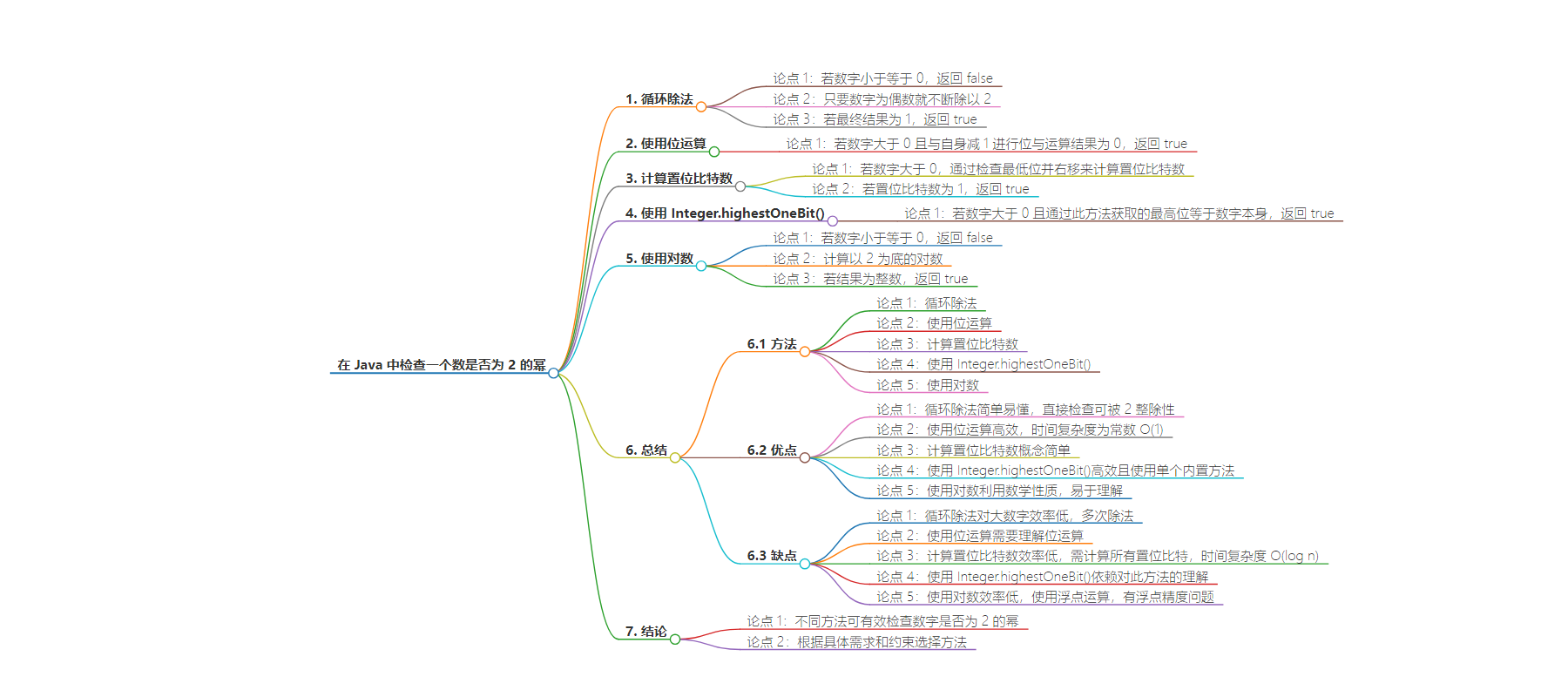包阅导读总结
1. 关键词:Java、Power of 2、Check、Methods、Advantages
2. 总结:本文介绍了在 Java 中检查给定数字是否为 2 的幂的不同方法,包括循环除法、位运算、计数置位、使用特定函数和对数运算,分析了每种方法的优缺点,并指出可根据具体需求和约束选择合适的方法。
3. 主要内容:
– 检查数字是否为 2 的幂的方法
– 循环除法
– 不断除以 2,检查余数,直到不能整除,最终判断结果是否为 1。
– 位运算
– 利用 2 的幂的二进制表示只有一位为 1 的特性,通过位运算判断。
– 计数置位
– 计算二进制表示中的置位数量,若为 1 则是 2 的幂。
– 使用 `Integer.highestOneBit()`
– 判断通过该方法获取的最高位是否等于数字本身。
– 使用对数
– 计算以 2 为底的对数,若为整数则是 2 的幂。
– 方法总结
– 分析了每种方法的优势和劣势。
– 如循环除法简单但对大数字效率低,位运算高效但需理解位操作等。
– 结论
– 可根据具体需求和约束选择合适的方法来检查数字是否为 2 的幂。
思维导图:
文章地址:https://www.javacodegeeks.com/check-if-a-number-is-power-of-2-in-java.html
文章来源:javacodegeeks.com
作者:Yatin Batra
发布时间:2024/7/3 10:33
语言:英文
总字数:701字
预计阅读时间:3分钟
评分:84分
标签:java 基础
以下为原文内容
本内容来源于用户推荐转载,旨在分享知识与观点,如有侵权请联系删除 联系邮箱 media@ilingban.com
In this article, we will explore different approaches to check if a given number is a power of 2 in Java. We will cover the following methods:
- Loop Division
- Using Bitwise & Operations
- Counting Set Bits
- Using
Integer.highestOneBit() - Using Logarithm
1. Loop Division
This approach involves continuously dividing the number by 2 and checking if the remainder is ever not zero.
public class PowerOf2 { public static boolean isPowerOfTwo(int n) { if (n <= 0) { return false; } while (n % 2 == 0) { n /= 2; } return n == 1; } public static void main(String[] args) { System.out.println(isPowerOfTwo(16)); // true System.out.println(isPowerOfTwo(18)); // false }}
In the above code:
- We check if the number is less than or equal to zero. If it is, we return
false. - We repeatedly divide the number by 2 as long as it is even.
- Finally, we check if the resulting number is 1.
2. Using Bitwise & Operations
This method utilizes the property that powers of 2 have exactly one bit set in their binary representation.
public class PowerOf2 { public static boolean isPowerOfTwo(int n) { return n > 0 && (n & (n - 1)) == 0; } public static void main(String[] args) { System.out.println(isPowerOfTwo(16)); // true System.out.println(isPowerOfTwo(18)); // false }}
In the above code:
- We check if the number is greater than zero.
- We use the bitwise AND operation to check if the number has only one bit set.
3. Counting Set Bits
This approach counts the number of set bits (1s) in the binary representation of the number.
public class PowerOf2 { public static boolean isPowerOfTwo(int n) { if (n > 0) { count += (n & 1); n >>= 1; } return count == 1; } public static void main(String[] args) { System.out.println(isPowerOfTwo(16)); // true System.out.println(isPowerOfTwo(18)); // false }}
In the above code:
- We check if the number is less than or equal to zero.
- We count the number of set bits by checking the least significant bit and right-shifting the number.
- We return
trueif the count of set bits is 1.
4. Using Integer.highestOneBit()
This method uses the Integer.highestOneBit() function to check if the number is a power of 2.
public class PowerOf2 { public static boolean isPowerOfTwo(int n) { return n > 0 && Integer.highestOneBit(n) == n; } public static void main(String[] args) { System.out.println(isPowerOfTwo(16)); // true System.out.println(isPowerOfTwo(18)); // false }}
In the above code:
- We check if the number is greater than zero.
- We use the
Integer.highestOneBit()method to get the highest bit of the number. - We check if this highest one-bit is equal to the number itself.
5. Using Logarithm
This approach uses the mathematical property that if a number is a power of 2, its logarithm base 2 should be an integer.
public class PowerOf2 { public static boolean isPowerOfTwo(int n) { if (n <= 0) { return false; } double log2 = Math.log(n) / Math.log(2); return log2 == Math.floor(log2); } public static void main(String[] args) { System.out.println(isPowerOfTwo(16)); // true System.out.println(isPowerOfTwo(18)); // false }}
In the above code:
- We check if the number is less than or equal to zero.
- We calculate the logarithm base 2 of the number.
- We check if the result is an integer.
6. Summary
| Method | Advantages | Disadvantages |
|---|---|---|
| Loop Division |
|
|
| Using Bitwise & Operations |
|
|
| Counting Set Bits |
|
|
Using Integer.highestOneBit() |
|
|
| Using Logarithm |
|
|
7. Conclusion
By using these different methods, you can efficiently check if a given number is a power of 2 in Java. Each method has its advantages and can be chosen based on the specific requirements and constraints of your problem.
